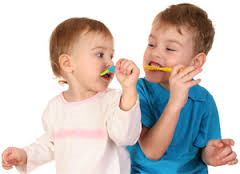Dr. Steven Ota, DDS, a dentist and oral surgeon of thirty years and a father of four, cautions that parents may want to be careful that the tooth fairy doesn’t give too much money. He once overheard his young boys sharing their perspective on dental hygiene. One boy told the other, “If we pull out three of your teeth, we’ll have enough money to buy that toy”.
Providing the foundation for a mouth full of healthy pearly whites is important business though. The CDC shows that 42% of kids ages 2 to 11 have had cavities in their baby teeth. So, while dental hygiene may not be the most urgent priority to new parents or young kids, there are a few tips Dr. Ota and other dentists suggest that you’ll want to know:
- Not every cold symptom is a teething symptom: Symptoms that your baby’s gums hurt due to teething include biting hands and toys. However, diarrhea, fever and nasal congestion are probably something else.
- Favor natural teething remedies: If your baby’ gums seem to be hurting, you can offer a frozen teething ring or cold wash cloth to really help soothe those gums. However, think twice before medicating. “I’m not a big fan of over-the-counter numbing tablets, drugs, or herbs,” explains Dr. Ota, “because your baby’s body has to process them. I’m also not a fan of giving ibuprofen or acetaminophen, unless your baby has a fever, to avoid over-medicating”.
- Let your baby watch you brush: Are you looking for a way to make brushing baby teeth easier? Try modeling tooth-brushing. “If you have them watch you first,” suggests Dr. Ota, “They’ll want you to brush their teeth too.”
- Now brush those pearly whites: To brush your baby’s teeth, you can use a toothbrush as the American Dental Association (ADA) suggests or a washcloth to wipe them off. It’s a good idea to brush 2-3 times per day, after meals. By regularly brushing your baby’s teeth, you’ll establish good hygiene routines, early.
- Bacteria transfer from your mouth: You can transfer bacteria from your mouth to your baby’s, so it’s not a good idea to share utensils. Why does this matter? The bacteria from your mouth can promote decay and cavities in your baby’s mouth.
- Get your fluoride: There are lots of studies that show that fluoride strengthens tooth enamel. You want your baby to get 0.25mg/day of fluoride, up until the age of three (then your target increases to 0.5mg/day). You can contact your water company to find out how much fluoride is in your water. Too much fluoride can cause Fluorosis, a condition which causes tooth discoloration. However, too little fluoride can lead to decay. Fluoride is added to tap water. But if you give bottled water, your baby may not be getting enough—you can remedy this by purchasing fluoride drops. Are you wondering if you should care if the baby teeth don’t get enough fluoride? The fluoride actually also helps strengthen the permanent teeth before they’re in, too.
- Prevent bottle decay: If your baby falls asleep with a bottle in their mouth, their teeth sit in a milk bath, which can promote decay. So, it’s best to avoid letting your infant fall asleep with a bottle in her mouth.
- Juice isn’t good: Some people think juice is a good source of fruit or veggies, but it’s full of sugar, so it’s a lot like just giving them soda.
- Go ahead and suck on that thumb (or paci): Some people think that if a baby sucks on fingers thumbs or a sippy cup, it will cause crooked teeth, but that’s actually a wives’ tale. If your child discontinues the sucking by age 5, the baby’s teeth will usually straighten back out on their own. However, there can be permanent changes to the bone, after age 5. “I’m a fan of sippy cups,” explains Dr. Ota, “It doesn’t matter if they have a straw or lip, but the bottle should be gone by age 5.”
- Don’t panic during the ugly duckling phase: Kids go through a bit of an ugly duckling phase. Teeth come in a bit crooked, and there’s a stage where they have a mix of adult and baby teeth—it looks a bit gnarly. Don’t worry too much though. Nature will do its thing, and they’ll straighten out some and end up looking normal.
Now you have the secrets to good dental care for your little ones. So go brush those little teeth. Or, if all this doesn’t work out, see if you can talk the kids into at least putting a few teeth towards the send-Mommy-to-the-spa fund.
If you enjoyed this article and want to see more from Mama Lovejoy, you can automatically receive articles in your Facebook newsfeed by “liking” the Mama Lovejoy Facebook page.
